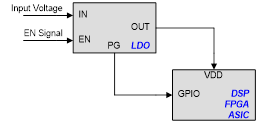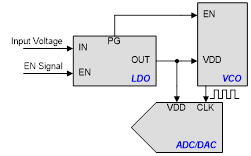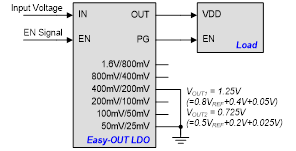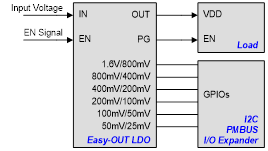RICHTEK Low-Noise LDOs for Industrial Applications
Willie Wen, Sophia Tong | AN082
This application note reviews the general applications and system requirements in industrial fields. Linear regulators (LDOs) are widely used in various applications due to their advantages, including low-noise output voltage, compact size, low shutdown current, and cost-effectiveness compared to switching regulators. This document not only highlights important characteristics that indicate low-noise performance but also introduces the RICHTEK low-noise LDO families with their featured advantages. Furthermore, it provides a practical guide for the RICHTEK low-noise LDO families to help users choose the appropriate solutions that meet their system requirements.
1 Industrial Application Scenario and System Requirement
Figure 1 illustrates a simple scenario for industrial systems, where the input voltage source is typically 12V or 24V. Noise-sensitive systems, which feature a lower output voltage, are used in wireless infrastructure such as Active Antenna Units (AAU) and Multiple-Input Multiple-Output (MIMO) systems, as well as in RF amplifiers and DACs/ADCs for instrumentation and medical equipment.
To provide and regulate a lower output voltage from a higher input voltage source to the noise-sensitive systems, a switching regulator is typically used as the second power stage. This approach increases power conversion efficiency and minimizes power dissipation in the internal passive elements. However, the switching regulator may introduce internal noise from the switching transistors and external noise from the input power sources through the cables. Therefore, a LDO with noise reduction features is necessary to be placed between the switching regulator and the noise-sensitive systems. This low-noise LDO will filter out noise at its input terminal and provide clean, linear power at the output terminal, minimizing voltage measurement mismatches in the signal chain of the noise-sensitive systems.

Figure 1. Simple Scenario for Industrial Systems
2 Low-Noise LDO
The low-noise LDO is designed for noise-sensitive systems and features three key characteristics: Power Supply Rejection Ratio (PSRR), output noise, and noise spectral density. PSRR is used to filter out noise at the input terminal that originates from external sources and the output of the switching regulator, thus eliminating the need for additional input filter components. As shown in Figure 2, the typical PSRR curve of the low-noise LDO demonstrates how PSRR reflects the variation in output ripple voltage caused by fluctuations in the input voltage. This relationship can be expressed in logarithmic form as the equation below:

where DVIN is the input ripple voltage, DVOUT is the output ripple voltage, both measured at the same specific frequency.
Additionally, the output current will also influence PSRR due to the output impedance and internal compensation of the LDO. Therefore, it is recommended to select an LDO with high PSRR to eliminate the input noise reflected at the output terminal.

Figure 2. Typical PSRR Curve of Low-Noise LDO
The next important characteristic of the low-noise LDO is the output noise spectral density curve versus frequency, which is a spectral plot with amplitude in µV/√Hz, as shown in Figure 3. This plot helps users to evaluate the output noise spectrum of the low-noise LDO to ensure it meets the system requirements.
Furthermore, after obtaining the measured data from Figure 3, the output noise voltage can be estimated across the bandwidth of the industrial standard (typically from 10Hz to 100kHz) by using the midpoint rule of the Riemann integral as shown in the equation below:

where NoiseN is the noise spectral density with amplitude in µV/√Hz at the Nth frequency point, and fN and fN+1 are the frequencies at the Nth and N+1th points.

Figure 3. Output Noise Performance
Using the noise equation provided above, the noise levels depicted in Figure 3 can be calculated as 7.67, 8.75, 11.25, and 15.92 µVRMS at output voltages of 0.8V, 1.5V, 3.3V, and 5V, respectively, across a bandwidth from 10Hz to 100kHz.
The design examples below showcase low-noise LDOs that are used for RF biasing, PLL, VCO, ADC & DAC, SerDes, FPGA, and DSP applications. Our latest low-noise LDO family, the RTQ2538/RTQ2539/RTQ2540, is specially designed for noise-sensitive applications. This family features high PSRR, up to 40dB at around 500kHz, and excellent noise immunity to 6.8µVRMS. Additionally, the output noise immunity can be enhanced by adding an external bypass capacitor to the NR/SS pin. It also includes an Enable input and a Power Good indicator for easier sequencing control.
|

|

|
|
Figure 4(a). Design Example for FPGA
|
Figure 4(b). Design Example for ADC/DAC
|
3 Low-Noise LDO with Easy-OUT Function
In other industrial fields, the I/O expander is another popular application that provides general-purpose I/O (GPIO) pins for CPUs through the I2C or PMBUS interface. The GPIO count, ranging from 2 to 48 pins normally, can reduce the total BOM cost of products by minimizing the board area and simplifying the software development. Thus, our low-noise Easy-OUT LDO family, the RTQ2532/RTQ2533/RTQ2537, is specifically designed for this application and eliminates the requirement for an external resistive voltage divider, as shown in the design examples 5(a) and 5(b) below. The output voltage can be set by a pin-strapped mechanism to implement dynamic output voltage control. This family features high PSRR, up to 40dB at around 500kHz, and excellent noise immunity to 6.8µVRMS. With the external NR/SS pin, the output noise immunity can be enhanced by adding an external bypass capacitor. It also includes an Enable input and a Power Good indicator for easier sequencing control.
|

|

|
|
Figure 5(a). Example Circuit of Easy-OUT LDO
|
Figure 5(b). Design Example for I/O Expander
|
4 RICHTEK Low-Noise LDOs Overview
RICHTEK offers a variety of low-noise LDOs to meet the needs of noise-sensitive applications, featuring the following characteristics:
(1) Superior low noise, as low as 6.8µVRMS.
(2) Support for a single input supply voltage as low as 1.1V: A single supply input can simplify the PCB layout by eliminating the need for an additional external power rail, thereby facilitating system design. Additionally, in applications requiring lower output voltages, the minimum input voltage is an important characteristic for minimizing the dropout voltage under conditions of larger output currents. Both low-noise LDO families support an input supply voltage as low as 1.1V.
(3) Support for output voltages as low as 0.5V with 1% accuracy for higher-performance industrial systems that require the lowest power consumption.
(4) Support for extremely low dropout voltage to minimize LDO power loss, particularly important when industrial systems require greater operating current capability and the output voltage must be regulated as close to the input voltage as possible. For example, the RTQ2540H features a maximum dropout voltage of only 145mV at an output current of up to 4A.
(5) A small size of 2.2x2.5 mm to meet the constraints of tight PCB layout spaces.
4.1 RICHTEK Low-Noise LDOs
Table 1. Small Size with Extremely Low Dropout Voltage
|
Part Number
|
IOUT (A)
|
VIN Range (V)
|
VOUT Range (V)
|
Accuracy (%)
|
RMS Noise
(µVRMS)
|
Typ. PSRR @ 500kHz (dB)
|
Dropout @ Full Load (mV)
|
Quiescent Current (mA)
|
Package(s)
|
Features
|
|
RTQ2552A
|
2
|
1.1 ~ 6.5
|
0.8 ~ 5.2
|
±1%
|
6.8
|
40
|
90
|
3.7
|
WDFN-10L-2.5x2.5
|
EN, SS, PG
|
|
RTQ2538H
|
2
|
1.1 ~ 6.5
|
0.8 ~ 5.5
|
±1%
|
6.8
|
40
|
90
|
3.7
|
WQFN-12L-2.2x2.5
|
EN, SS, PG
|
|
RTQ2539A
|
3
|
1.1 ~ 6.5
|
0.8 ~ 5.5
|
±1%
|
6.8
|
40
|
130
|
4.3
|
WQFN-12L-2.2x2.5
|
EN, SS, PG
|
|
RTQ2539C
|
3
|
1.1 ~ 6.5
|
0.5 ~ 5.5
|
±1%
|
8.7
|
40
|
130
|
4.3
|
WDFN-12L-2.2x2.5
|
EN, SS, PG
|
|
RTQ2540H
|
4
|
1.1 ~ 6.5
|
0.8 ~ 5.5
|
±1%
|
6.8
|
40
|
145
|
4.3
|
WQFN-12L-2.2x2.5
|
EN, SS, PG
|
Table 2. Easy-OUT by Pin-Strapping
|
Part Number
|
IOUT (A)
|
VIN Range (V)
|
VOUT Range ADJ. (V)
|
VOUT Range Easy-Out (V)
|
Accuracy (%)
|
RMS Noise
(µVRMS)
|
Typ. PSRR @ 500kHz (dB)
|
Dropout @ Full Load (mV)
|
Package(s)
|
Features
|
|
RTQ2532N
|
2
|
1.1 ~ 6.5
|
0.8 ~ 5.5
|
0.8 ~ 3.95
|
±1%
|
6.8
|
40
|
125
|
VQFN-20L-3.5x3.5
|
EN, SS, PG, 50mV Pin-Strapped
|
|
RTQ2532W
|
2
|
1.1 ~ 6.5
|
0.8 ~ 5.5
|
0.8 ~ 3.95
|
±1%
|
6.8
|
40
|
125
|
VQFN-20L-5x5
|
EN, SS, PG, 50mV Pin-Strapped
|
|
RTQ2532E
|
2
|
1.1 ~ 6.5
|
0.5 ~ 5.5
|
0.5 ~ 2.075
|
±1%
|
6.8
|
40
|
125
|
VQFN-20L-3.5x3.5
|
EN, SS, PG, 25mV Pin-Strapped
|
|
RTQ2532E1
|
2
|
1.1 ~ 6.5
|
0.5 ~ 5.5
|
0.5 ~ 2.075
|
±1%
|
6.8
|
40
|
125
|
VQFN-20L-5x5
|
EN, SS, PG, 25mV Pin-Strapped
|
|
RTQ2533W
|
3
|
1.1 ~ 6.5
|
0.8 ~ 5.5
|
0.8 ~ 3.95
|
±1%
|
6.8
|
40
|
180
|
VQFN-20L-3.5x3.5
|
EN, SS, PG, 50mV Pin-Strapped
|
|
RTQ2533E
|
3
|
1.1 ~ 6.5
|
0.5 ~ 5.5
|
0.5 ~ 2.075
|
±1%
|
6.8
|
40
|
180
|
VQFN-20L-3.5x3.5
|
EN, SS, PG, 25mV Pin-Strapped
|
|
RTQ2537
|
4
|
1.1 ~ 6.5
|
0.8 ~ 5.5
|
0.8 ~ 3.95
|
±1%
|
6.8
|
40
|
240
|
VQFN-20L-3.5x3.5
|
EN, SS, PG, 50mV Pin-Strapped
|
|
RTQ2537E
|
4
|
1.1 ~ 6.5
|
0.5 ~ 5.5
|
0.5 ~ 2.075
|
±1%
|
6.8
|
40
|
240
|
VQFN-20L-3.5x3.5
|
EN, SS, PG, 25mV Pin-Strapped
|
5 Conclusion
Based on the specific requirements of industrial systems mentioned above, RICHTEK low-noise LDOs feature higher PSRR, lower noise levels, and ease of use, making them highly suitable for industrial applications without compromising system functionality.
The above summary concludes the contents covered in this application note. To stay informed with more information about our products, please subscribe to our newsletter.